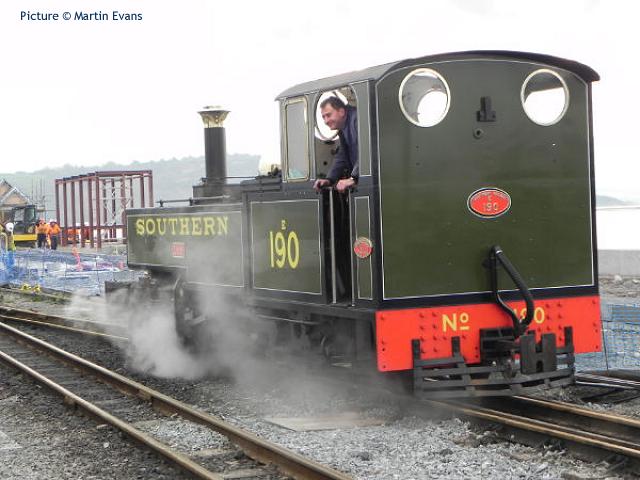NORTH WALES COAST RAILWAY:NOTICE
BOARD
Rheilffordd arfordir gogledd Cymru: Hysbysfwrdd
18 February 2013
 Last
issue
Last
issue Archive
Archive Share this issue
Tweet
News of updates
@nwrail1
Contributions and comments are encouraged: see the Contributions Page
This site is dedicated to all our regular contributors and supporters, and especially the rail staff of North Wales.
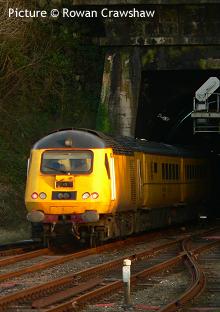
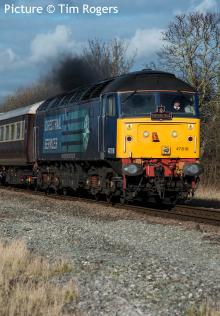
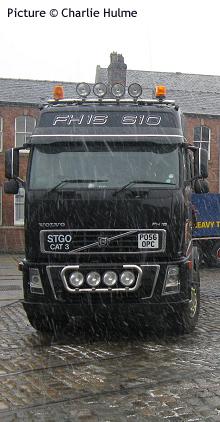
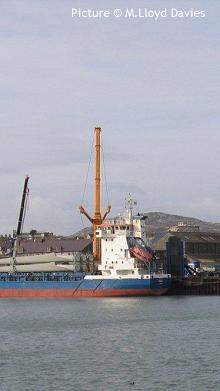
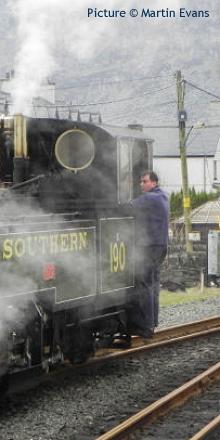
Forthcoming events
This list may be out of date if you are reading an archived page. For the current list visit our Calendar.
February 2013
Thursday 21 February LCGB North West Mike Taylor "Preston and North"
Thursday 28 February Merseyside Railway History Group Dave Southern: Rails to Blaenau Ffestiniog
March 2013
Friday 1 March Clwyd Railway Circle The Committee & Larry Davies. AGM followed by the talk “60 years ago – Diamond days” After the formality is over, we look forward to the talk by one of our favourite speakers.
Friday 8 March Altrincham Electric Railway Society "German Narrow Gauge Steam" a colour slide presentation by John Owen.
Saturday 9 March Railway and Canal Historical Society "Lost Canals of the East Midlands" by the Society's President, Dr. Wendy Freer
Monday 11 March Wrexham Railway Society 'A Circular Tour Of North Wales' John Hobbs
Thursday 14 March Llandudno and Conwy Valley Railway Society “Polish Steam” Brian Bollington & Pete Hanahoe
Monday 18 March RCTS Chester B.R in the early 1980’s By Tom Heavyside.
Thursday 21 March LCGB North West Tony Harrison "The Dragon's Last Roar"
23 March Llangollen Railway Diesel day
Thursday 28 March Merseyside Railway History Group AGM: Members Slides
April 2013
Friday 5 April Clwyd Railway Circle Michael Murphy 'Liverpool Overhead Railway' To finish off the season, a highly recommended speaker known for his light-hearted style of presentation. The talk will be followed by film footage of the railway in its heyday.
Monday 8 April Wrexham Railway Society 'The Railways Of Scotland' Les Nixon
Thursday 11 April Llandudno and Conwy Valley Railway Society “Chester to Holyhead English Electric traction 1984 – Present day” Steve Morris
Friday 12 April Altrincham Electric Railway Society "Current Developments on Metrolink" a digital presentation by Tony Williams, Manchester Area Officer, Light Rail Transit Association.
Saturday 13 April Railway and Canal Historical Society "The General Strike & the Railways" by Dr. Robin Smith
13 April Llangollen Railway Real Ale train evening
Monday 15 April RCTS Chester Meeting has been moved to 29 April ( see below)
Thursday 18 April LCGB North West John Sloane 'Steam Sheds and Diesel Depots'
19-21 April Llangollen Railway Spring Steam gala with return of the steam Railmotor 93 and newly restored Auto Trailer 92
Thursday 25 April Merseyside Railway History Group Richard Kells : Quiz and informal evening
Monday 29 April RCTS Chester Even Further Down Under: New Zealand In 2011 & 2012 By Geoff Morris.
May 2013
Thursday 9 May Llandudno and Conwy Valley Railway Society “The Buckley Railway” Paul Davies
Saturday 11 May Llangollen Railway Murder Mystery
Thursday 16 May LCGB North West AGM and Members/Visitors Slides & Digital Photos.
Sunday 19 May Llangollen Railway Teddy Bears Picnic
June 2013
1-2 June Llangollen Railway Day Out with Thomas weekend
8 June Llangollen Railway Real Ale train evening
22-23 June Llangollen Railway Heritage Railcar Gala
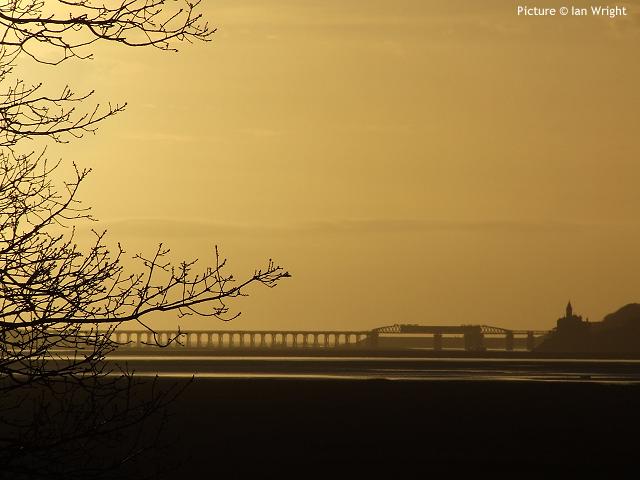
A Class 158 crosses the swing span of Barmouth viaduct across the Mawddach estuary, 15 February. Picture by Ian Wright.
67 029 on the Express
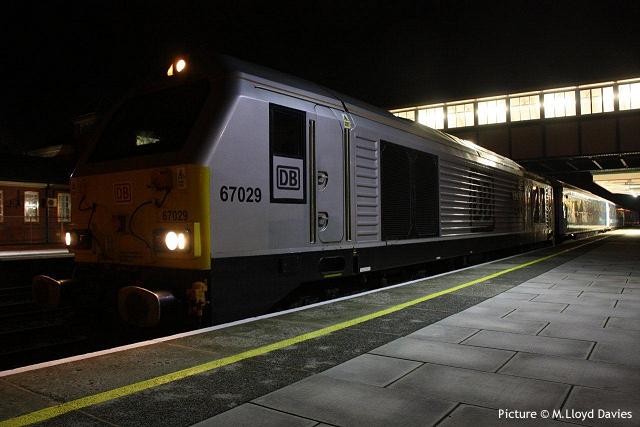
A 'stop press' news item: 67 029 Royal Diamond worked the 18:21 Cardiff - Holyhead express on 18 February standing in for the usual blue 67s, and was photographed at Bangor by M.Lloyd Davies.
New Measurement Train
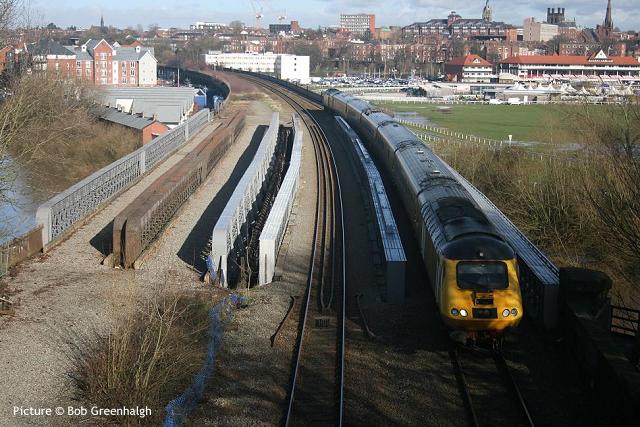
A track recording train formed of the HST-based 'New Measurement Train' visited North Wales on 14 February as train 1Q30, Derby to Holyhead and return to Crewe. We pick it it up crossing the River Dee at Chester in Bob Greenhalgh's picture above. Can anyone explain why some of the bridge metalwork has been left unpainted in the recent refurbishment project? The attached footbridge over the river is still shut and a notice says it will 'open in spring.'
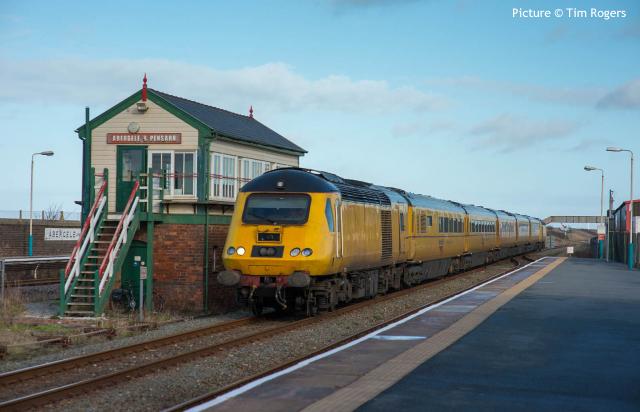
Abergele (Tim Rogers).
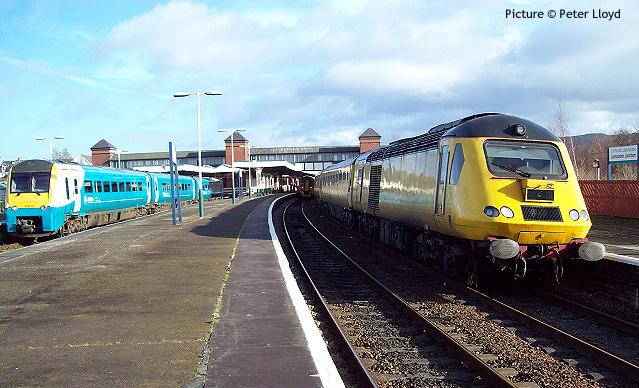
Llandudno Junction, at 14:20 waiting for the signal in platform 4. 175 115 is in Platform 2 on a Llandudno branch turn and a 158 calls at Platform 3 (Peter Lloyd).
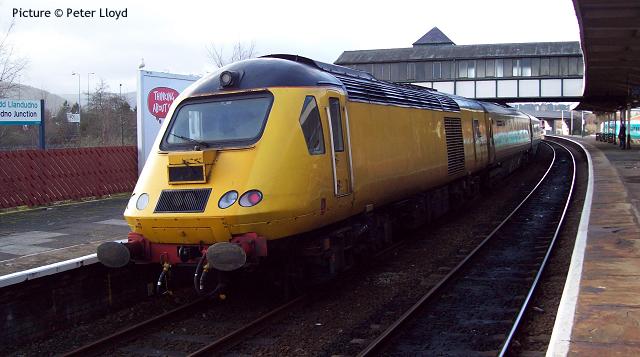
Both Class 43 locos were buffer-fitted versions on this occasion. This is 43 014 - the numbers are on these locos are very hard to spot.
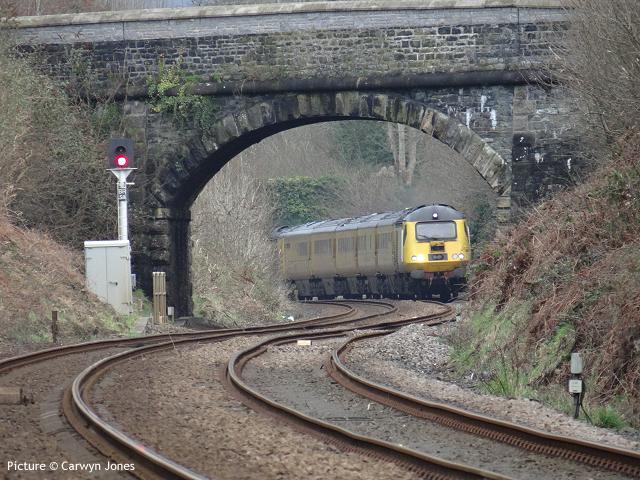
Carwyn Jones deployed his telephoto lens to capture the train approaching Llanfair PG, having just left the single-track section across the Britannia Bridge.
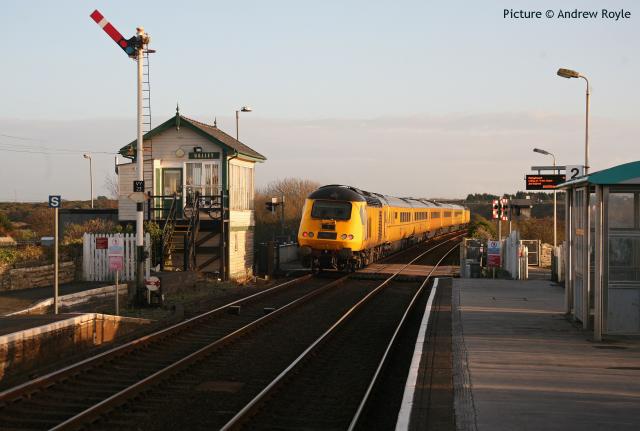
43 013 trailing (with 43 014 leading) through Valley on the return run. Picture by Andrew Royle who tells us that as things stand, the plan is that a loco-hauled set will cover the North Wales coast and Welsh Marches routes for track geometry monitoring in future, so this may be the last appearance of the NMT along the Coast . However, plans have been changed before, so time will tell.
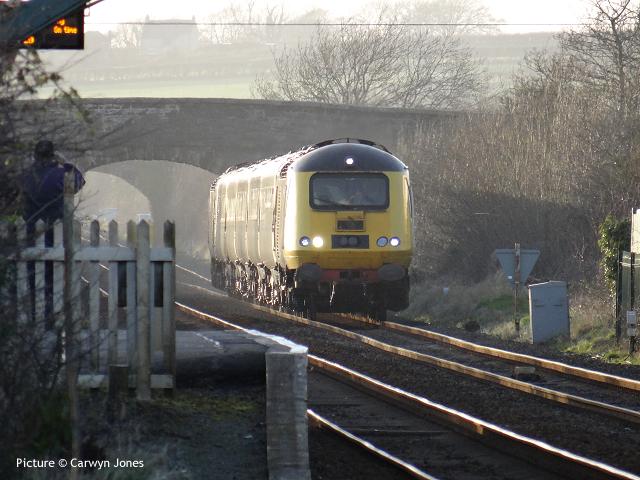
Approaching Llanfair PG station the return run (Carwyn Jones) ...
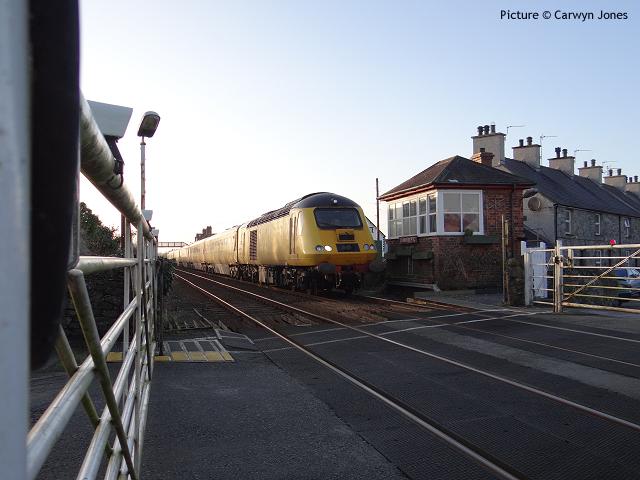
... and at the level crossing in a wider-angle view (Carwyn Jones).
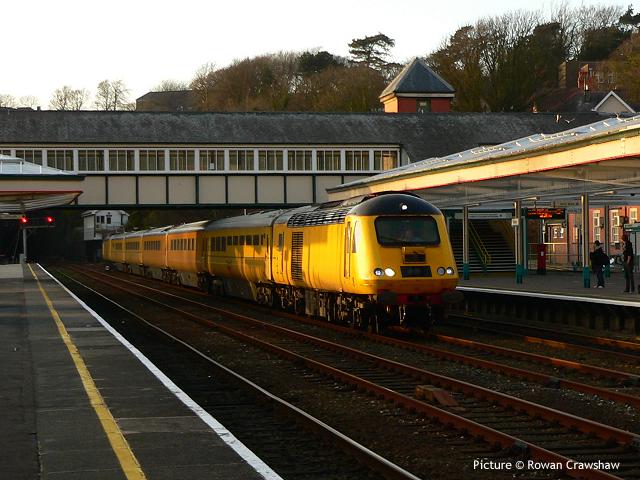
Bangor (Rowan Crawshaw).
Shrewsbury-Chester Rail Users Association
A Public Meeting will be held on Wednesday 6 March 2013 starting at 19:30 in St Mary’s Church Social Club, Regent St, Wrexham when the subject will be: Track re-doubling, opportunities after 2015. The speaker will be Mr Michael Bagshaw, Commercial Director, Arriva Trains Wales. Followed by a Question and Answer session. Visitors are most welcome to attend.
Valley Flasks - picture by Peter Basterfield
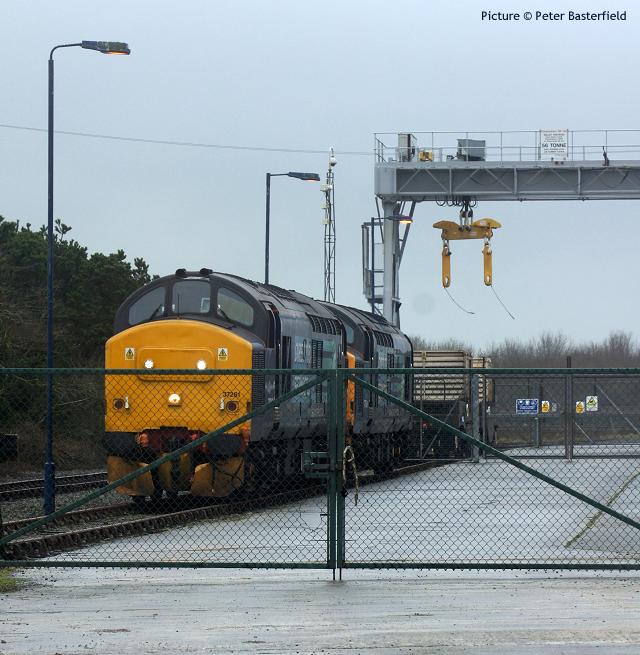
Not too long ago, views of the flask train serving Valley for Wylfa Power Station were a 'staple diet' of this page, but in 2013 such a train is an unusual event. One did run on 13 February, and Peter Basterfield used public viewpoints at Valley to record the working for us. Above, the view from the road entrance to the sire on the A5 road. The DRS locomotives are 37 261 (nearest the camera) and 37 601 Class37 - Fifty. It would appear that the flasks, once loaded, are kept separate until departure time.
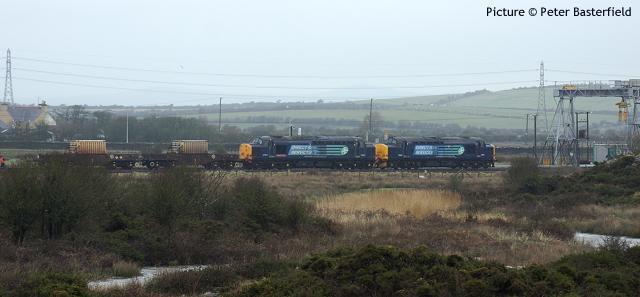
Above, the locos propel the two FNA wagons from the loading point ...
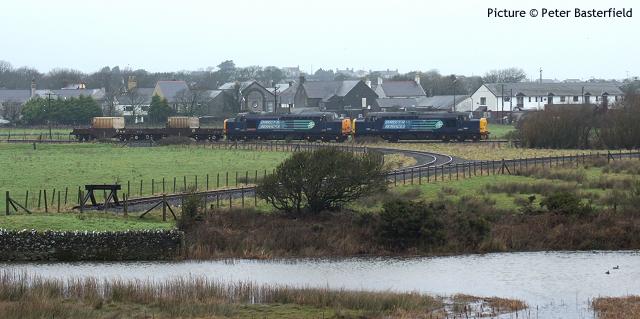
... and round the triangle towards Valley station. The lines in the foreground allow the train to be reversed so that the loco which leads the train from Crewe westbound usually also leads it eastbound to Crewe.
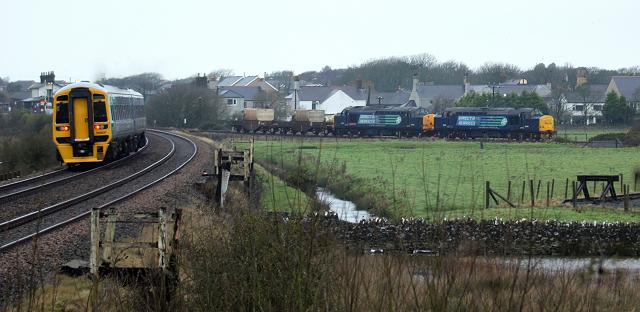
The public footpath from the station alongside the line - note the two 'ladder stiles' - is a favourite haunt of photographers, especially when steam locos use the triangle to turn round and haul their trains chimney-first from Holyhead. 158 837 passes with the 11:08 Birmingham International - Holyhead.
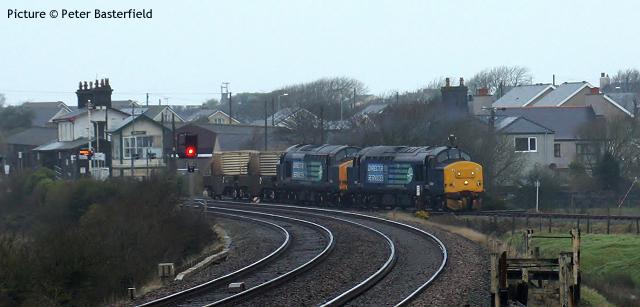
The train reverses out, at a maximum allowed speed of 15 mph, on to the main line in Valley station, having previously contacted the signaller who will have lowered the level crossing barriers, change the points and clear a 'ground disk' signal, just visible here alongside the train to authorise the movement. This signal is interlocked with a 'trap point' which will derail any vehicle that passes it when the signal is not clear.
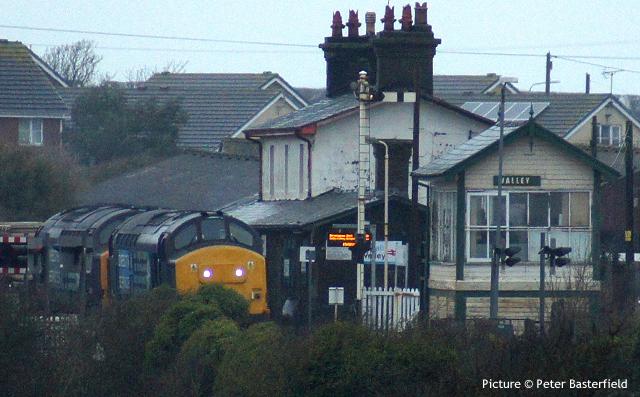
Once safe behind the Valley home signal (VY23), the train can leave for Crewe when the line is clear as far as Gaerwen, and this signal is 'pulled off' by the signaller. This procedure is always carried out as expeditiously as possible. The station building at Valley is an original Chester and Holyhead structure to the design of Francis Thompson; compare the one at Flint, and the recently-refurbished original building at Prestatyn.
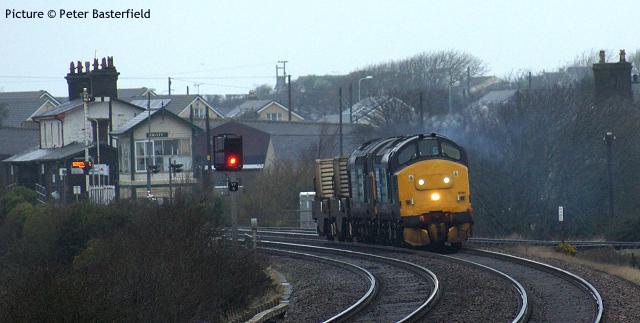
In Peter's final view, the train has departed and the signal has been put back to danger as soon as the train passed. The flasks are transported by road to and from Wylfa, which is on the north coast of Anglesey. The power station is currently operating just one of its two reactors, and is the only 'Magnox' station still operating; the fuel elements are no longer manufactured, and it will have to close if the current stock runs out before its definite closure date in 2014.
Northern Belle news
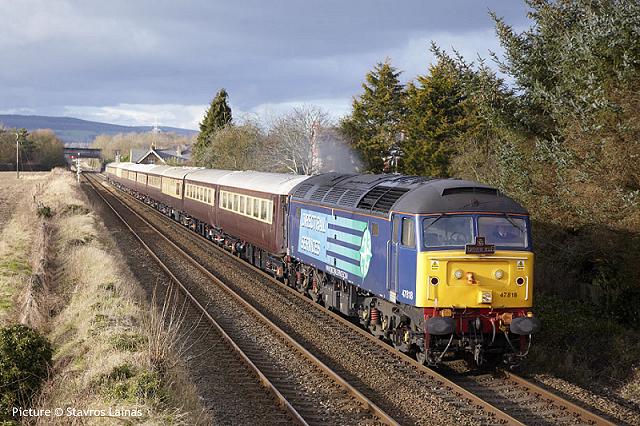
Friday 15 February saw the Northern Belle train take its luxury passengers on a tour, train 1Z49, from Coventry to Coventry via Crewe, Wrexham and Wolverhampton. It passed Stavros Lainas at Gobowen a little late at 15:24 with 47 818 leading. Based on pictures submitted to Rail Express magazine, the Northern Belle is apparently the most-photographed train in Britain; it certainly is very photogenic, and kept in very good external condition, including the DRS locos which haul it.
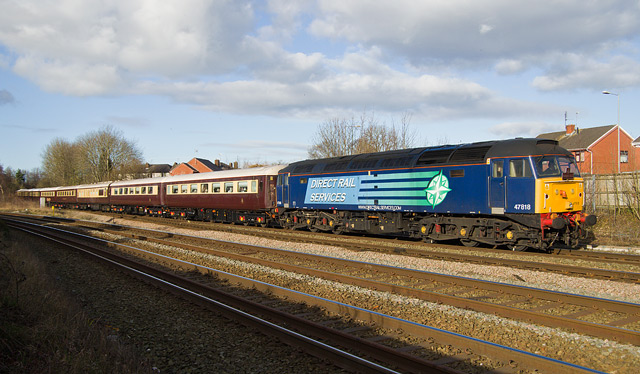
Seen above passing Wrexham, the third coach is Mark 1 Kitchen First No. 325 Duart. This coach has an interesting history, dating back to 1961 when British Railways London Midland Region, which had a great deal of autonomy at the time, ordered from Swindon Works a batch of 'Restaurant Kitchen First' carriages numbered M 306 - 342.
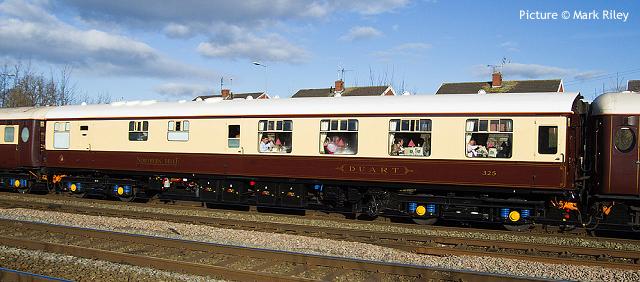
A close-up of 325 with diners enjoying their lunch: 'The only way to travel' says contributor Mark Riley. The RFK vehicles were intended to replace the remaining pre-war restaurant cars which were in use on principal expresses, and contained a kitchen and 24 first class seats; second-class passengers would be served meals in a coach coupled to the kitchen end. After a few years, it became clear that demand for meals was declining as journey times became shorter and people's eating habits changed, and all except two were rebuilt, retaining the kitchen but including a buffet counter in place of two of the seating bays. One of the two exceptions, M 325, was in use with the Royal Train, acting as a staff coach for members of the Royal Household. However it retained its BR maroon livery until 1977, as the train was being prepared for use in the Silver Jubilee events, when it was repainted Royal Train Claret and renumbered 2907 in the Royal series. In 1999 it was sold to the Venice Simplon Orient Express (VSOE) company which also runs the 'Northern Belle'.
A VSOE press release of Summer 2012 describes its recent overhaul: Duart, named after the Scottish castle on the Isle of Mull, is a testament to skilled British craftsmanship and will be officially launched in August. It began its transformation to become part of the Northern Belle rake in 2008. The carriage required a total refit and having been stripped back to its shell, a team of dedicated and skilled British craftsmen began the careful process of rebuilding the carriage to the renowned Orient-Express standard.
The marquetry was entrusted to Dunn & Son, a British family owned business, who have been creating marquetry since 1895, crafting the delicate artwork for the Titanic, Queen Mary and Queen Elizabeth cruise liners, as well as restoring the marquetry on the Northern Belle’s sister train, the British Pullman. Cheryl Dunn of Dunn & Son said 'The background veneer is a rich, dark walnut burr, inlaid with pink heather and white flowers. I handmade each panel individually in exactly the same way as my great-grandfather crafted the original Pullman panels back in the 1920’s. It has taken literally hundreds of hours to complete.'
See the Duart Castle website for the namesake castle in Scotland.
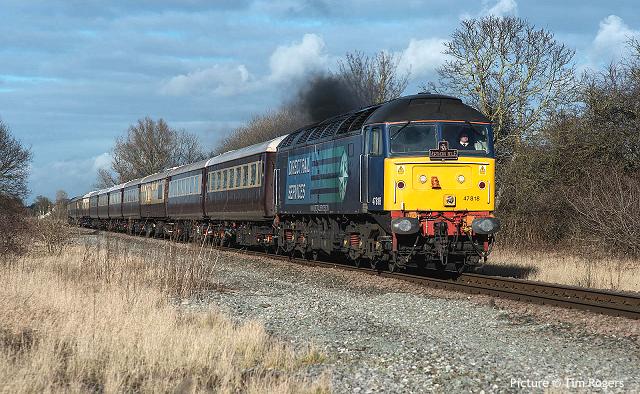
The extra coach takes the total number of seats on board to 276, and 'will be located at the end of the rake, making it ideal for groups, parties and weddings who may wish to book the entire carriage.' Not always at the end, it would seem from our pictures. Recently Mk1 coaches have not been allowed to carry passengers at the end of a train for supposed safety reasons, but we believe this ruling has recently been modified. Above, the train on the single-line Wrexham - Saltney Junction section heading for Chester (Tim Rogers).
Holyhead Ferry mishap
About 06:00 on 16 February, the Finnarrow, incoming from Dublin Port, ran into trouble at Holyhead; it is believed that it came alongside the berth with its stabilisers still protruding, and coming into contact with a fixed structure. All 77 passengers and 43 crew on-board the vessel were evacuated and the vessel was safely berthed.
The Finnarrow has been chartered as a relief ship for the Stena Nordica whilst the Stena Nordica relieved the Stena Europe which is in dry dock. Whilst repairs take place there will be major disruption in the Port of Holyhead as the Finnarrow is now stuck on the Irish Ferries berth, reportedly with the aft end visibly low, having taken in water.
150 213 in new colours
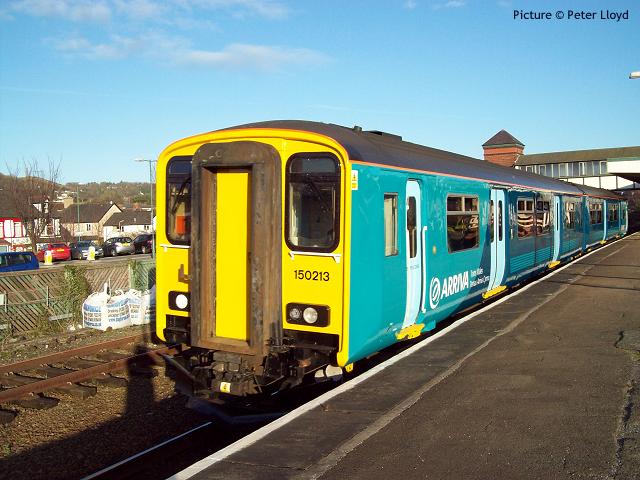
A start has been made on repainting Arriva Trains Wales Class 150 units in a version of 'Welsh Government' colours, but without the Welsh Government wording and symbols. The first to be done, 150 213, recently emerged from the LNWR works in Crewe, and after a a few days in South Wales headed north for a turn on the North Wales branches. 15 February found it on the Conwy Valley line; the photograph at Llandudno Junction is by Peter Lloyd.
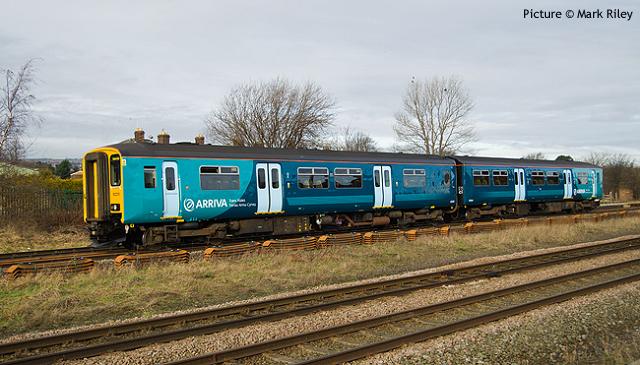
The next day it appeared on the Borderlands line: above, 150 213 approaches Wrexham General with the 09:32 Bidston General-Wrexham Central (Mark Riley).
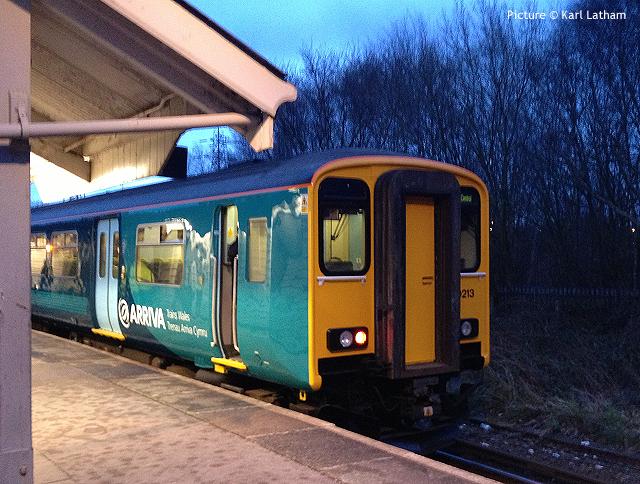
Standing at Bidston in fading light later in the day (Karl Latham). There are no changes to the interior, except additional 'no smoking' signs.
47 500: the final chapter - report by Charlie Hulme
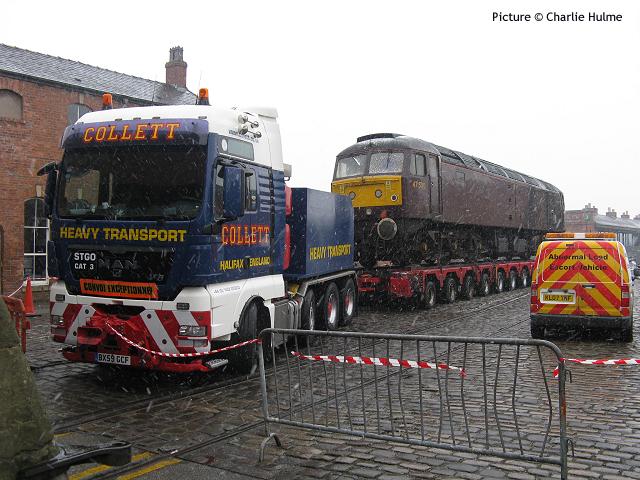
We have reported in recent issues how West Coast Railway Company loco 47 500 was moved into the Manchester Museum of Science and Industry for storage after derailing and catching fire on the main line at Ordsall Lane on 23 January. A visit to the museum on the afternoon of 13 February In a snowstorm) found it loaded on a 12-axle trailer ready to travel. A locomotive is a heavy object: around 120 tonnes in the case of a Class 47.
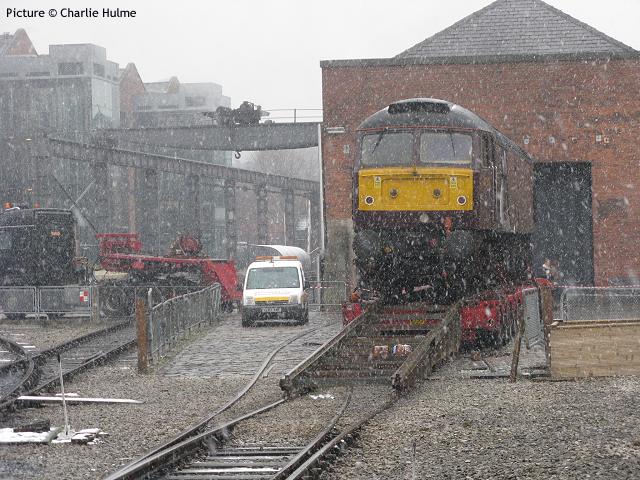
Destination was the West Coast Railway Company headquarters at Carnforth, Lancashire. The ensemble was spotted at Charnock Richard services on the M6 motorway at 07:30 the next day. An interim report on the accident has been uploaded by the Rail Accident Investigation Board, which reveals that the train was travelling at just 18 mph at the time of the derailment.
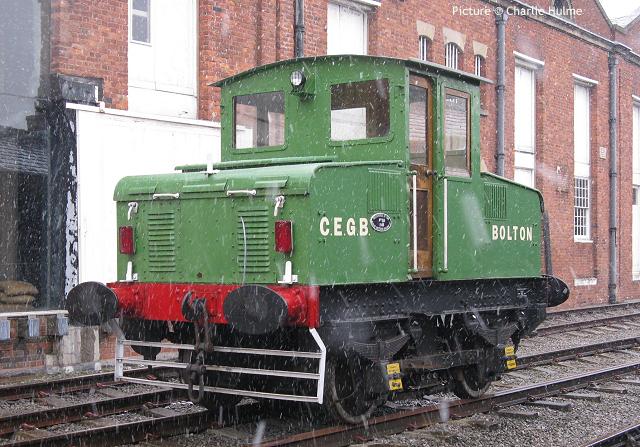
A portrait of the little battery-electric locomotive, which is in charge of shunting movements within the museum. It was built in 1944 by the Dick, Kerr Works, in Preston of English Electric for Upper Boat power station near Pontypridd in Wales, and still carries a registration plate issued by the Great Western Railway was so that it could run on that company's sidings to collect wagons of coal. That power station closed in 1972 and it was moved to Bolton by the Central Electricity Generating Board, for use at the power station there. It came to the museum after Bolton power station closed in 1979 (or possibly 1984?) Thanks to Vince Chadwick for assistance with this story: see Vince's World blog for a report on the replacement of the loco's batteries last autumn.
Wind turbines arrive at Holyhead - report by M.Lloyd Davies
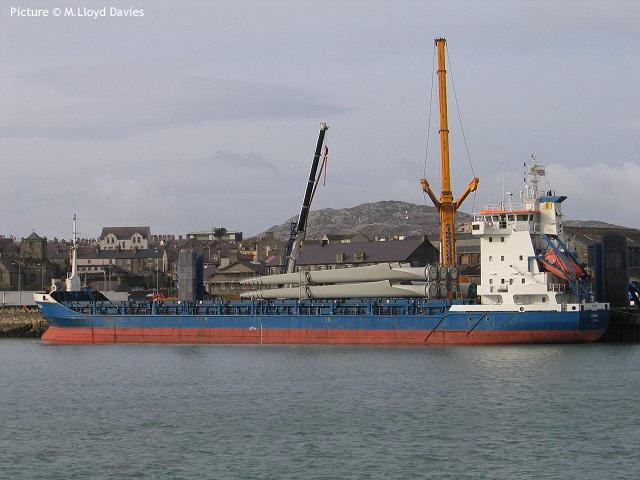
The MV Korsika arrived at the Port of Holyhead on 9 February bringing in from Germany its cargo of the two complete wind turbines for the Ysgellog Wind Farm at Rhosgoch. The concrete foundations for the turbines have already been prepared on site.
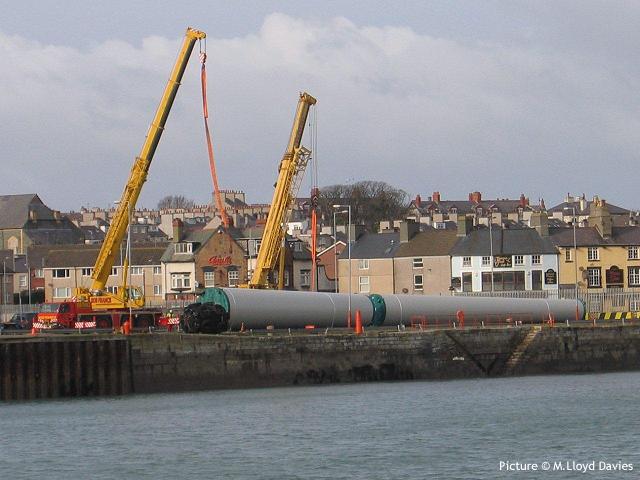
Each turbine will stand 92.5 metres high, and have a rated power output of 2.3 megawatts, enough for 1500 homes ... on a windy day, anyway. Much more information on the Ysgellog project website.
Wrexham Tramway depot
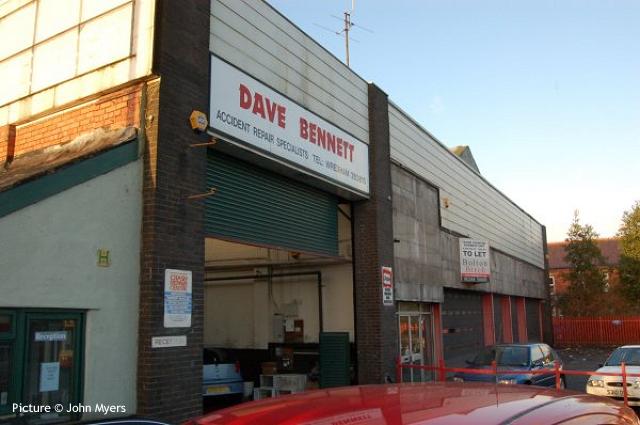
These pictures are by John Myers, who writes: 'With a comparatively modern-looking façade suited to its use, the Dave Bennett motor repair business is situated adjacent to the station and on the corner of Regent Street and Maesgwyn Road (Streetmap link.)
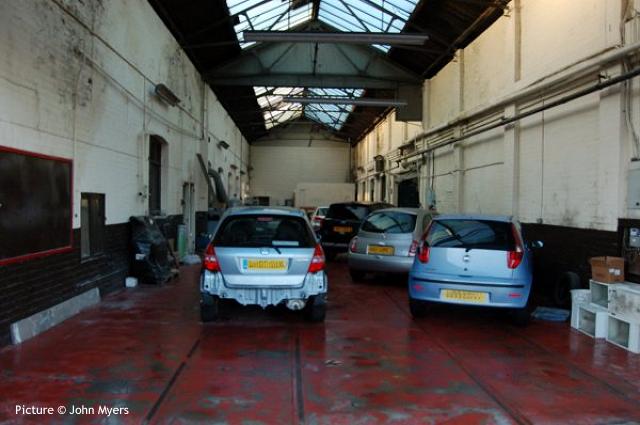
'However, a closer look indicates this building to be very much older than it looks and that it was equipped with tramlines, some of which remain in situ. With the permission of a staff member, I was able to take a few quick snaps that I hope others might be interested to see.
'Online documentation about the tramways of Wrexham seems to be comparatively limited so far but it seems that this 3'6" gauge, overhead electric, system opened in 1903 (a horse tramway had operated in the town earlier than this) and gave way to motor buses at the end of March 1927. Whilst I have found references to a since-demolished depot at Johnstown, I have found no information yet about the history of this building nearer the town centre.'
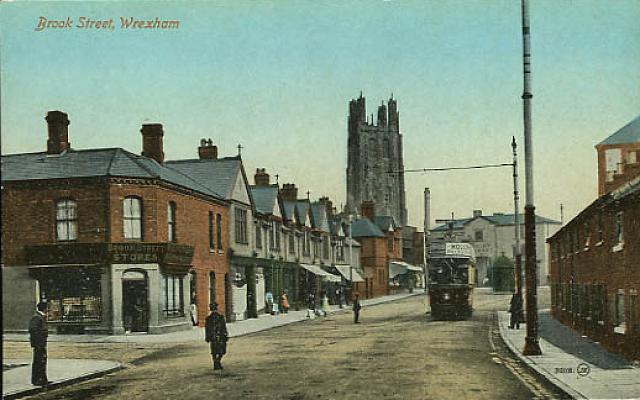
This old postcard shows one of the trams, which were run not by the Council but by the British Electric Traction company, which later became the owner or part-owner of many famous bus companies, including, for a while, part-ownership of the Crosville company which served Wrexham. Thanks to help from George Jones we can offer some more information. The publication The Tramways of South Lancashire and North Wales published by LRTA in 2003 covers the Wrexham system in a one-page article, including a map which shows the depot, with a note 'Maesgwyn Road depot: 2 tracks. No other details known.' Its life as a tram shed must have been short, before being converted to (or replaced by) a bus depot, as it eluded the compilers of the Ordnance Survey. The 1910 edition shows the site as a sports field with a 'pavilion' and the 1937 edition has 'Omnibus Depot'
The main depot for the system was at Johnstown, and with only ten cars in the fleet, it's not clear why another depot was built, unless there was a plan to shorten the line? Or maybe it was built with a view to conversion to buses in mind? The frontage does have something of a look of a typical bus garage.
It is of interest to note that the bodies of two Wrexham cars still exist in the museum store at Bersham having been recovered from a farm - a long term project is to restore one and if so it would make for a much needed 'wow!' object in Wrexham's museum. The Johnstown depot buildings survived into the 21st century only to be demolished in recent years.
If you can add to this story, please get in touch.
With 'Lyd' on the Ffestiniog - report by Martin Evans
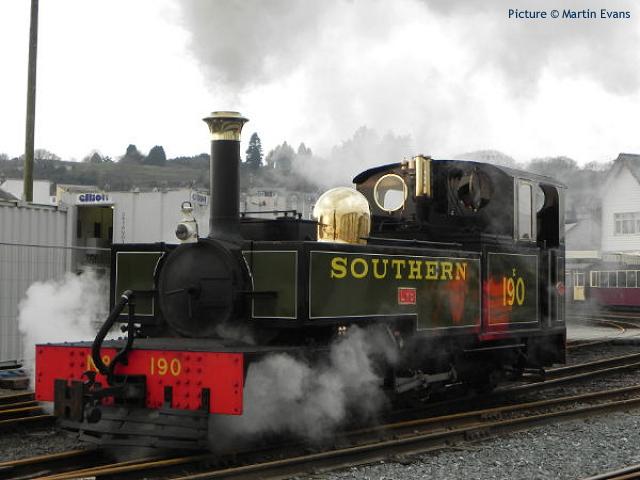
On 12 February I took a party of four to Porthmadog for a round trip on the Ffestiniog Railway. The loco in steam was replica Lynton and Barnstable loco no E190 Lyd. The pictures show it at Porthmadog Harbour (above) ...
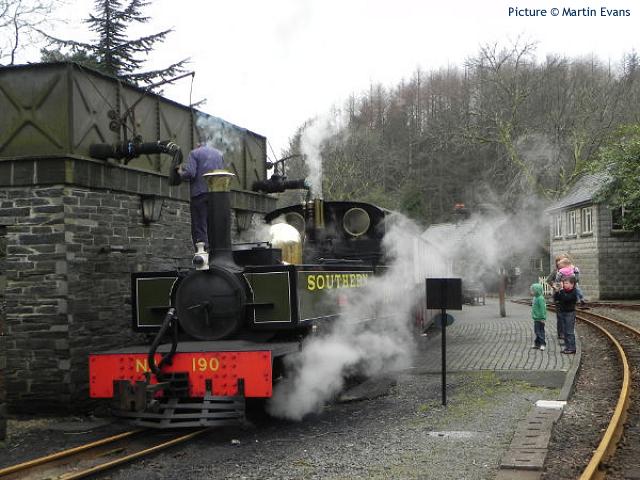
... taking water at Tan Y Bwlch, (permission was requested to cross over the running lines)...
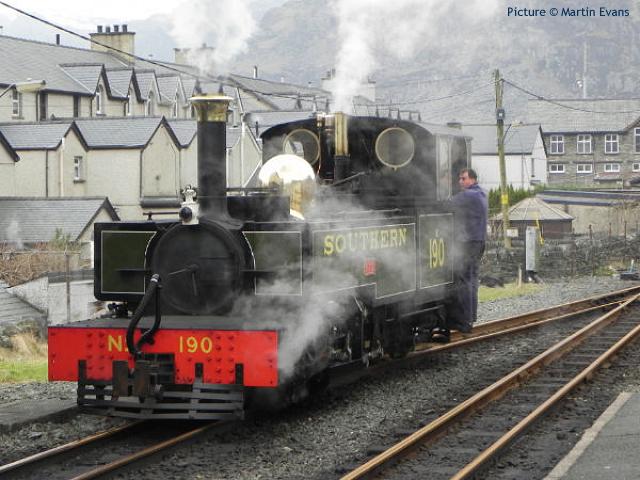
... and finally at Blaenau Ffestiniog.
In the background of this view at Porthmadog one can see the workforce carrying out the alterations to the track at Porthmadog and the new relay room and signal box being constructed. As well as the construction workers at Porthmadog there were a number of Network Rail apprentices on a visit to the railway; I believe they stay on the railway for a few weeks undertaking training on the permanent way.
North Wales Coast home page Archive Previous Notice Board
